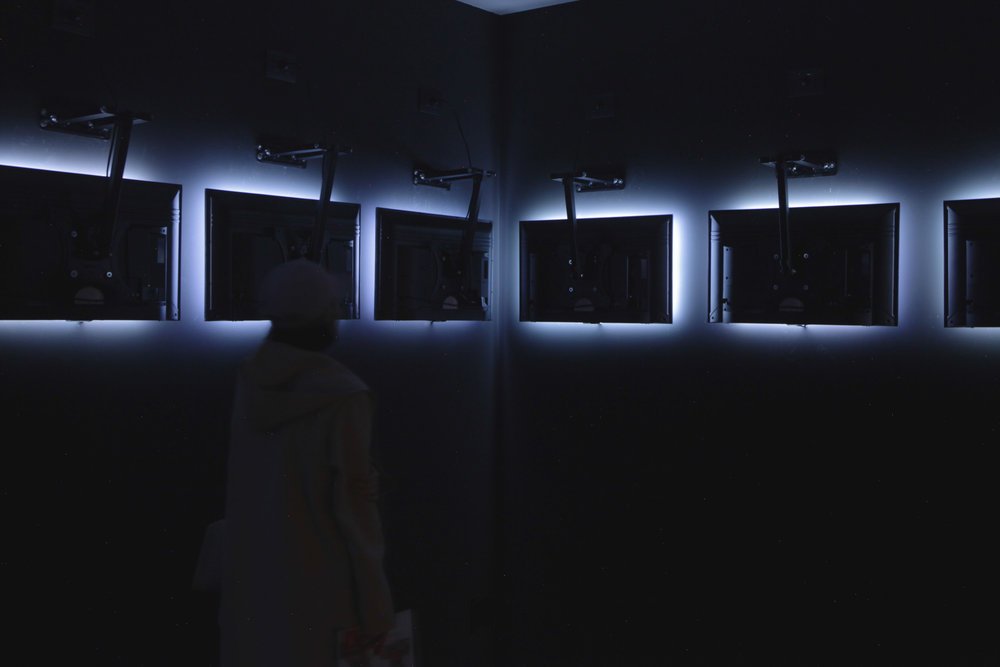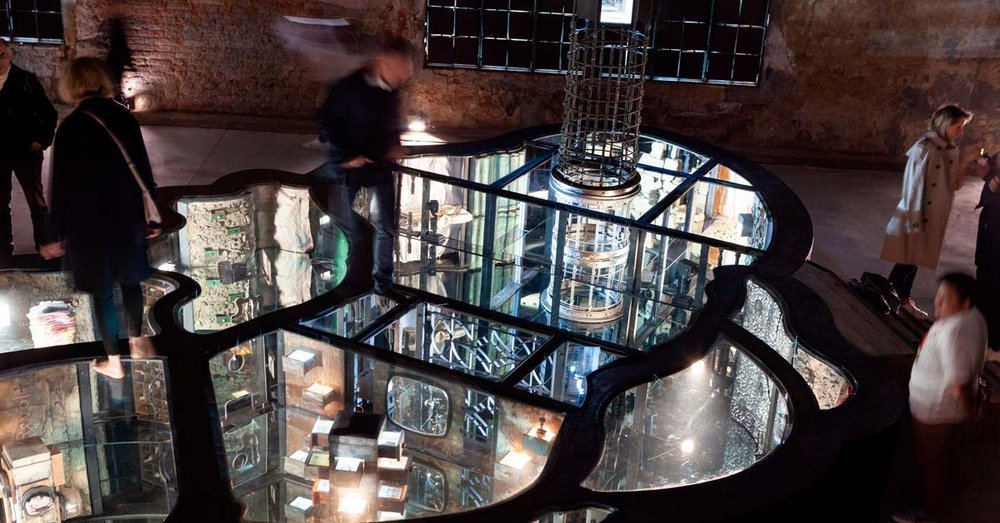Southeast Asian Pavilions at the 58th Venice Biennale
At the intersection of representation, cultural policy and commerce
By Ian Tee
Anurendra Jegadeva, 'Yesterday, in a Padded Room', 2015, PVC cushions with printed and painted canvas, two painted thrones with perspex boxes, painted inserts and LED lights, printed floor covering on wood, dimensions variable. Image courtesy of the artist.
The Venice Biennale's pavilion model is commonly viewed as the Olympics of the art world, carrying the connotations of competition and nationalist pride. For representing artists and their countries, the international event provides career-making exposure and an opportunity to project soft power. It remains strictly a state-level presentation and Southeast Asian nations have a relatively short participation history. It is also important to point out that regional representation is limited with the absence of Cambodia, Laos, Vietnam, Myanmar and Brunei.
This article looks at the pavilion model as a reflection of cultural policy and national interests, as well as its connections to the art market. These forces are most clearly expressed in the energy around Malaysia's first national pavilion as a result of the country's first regime change after its 2018 general elections. Aptly titled 'Holding up a Mirror', the group exhibition is curated by gallerist Lim Wei-Ling and features works by Anurendra Jegadeva, H.H. Lim, Ivan Lam, Zulkifli Yusoff. Bringing together artists from different ethnic, religious and cultural backgrounds, the show aims to shed light on the complexities of Malaysian identities.
Ivan Lam, 'One Inch', 2019, multimedia installation, dimensions variable. Image courtesy of the artist.
Despite operating under the auspices of the Ministry of Tourism, the project is an endeavor driven by individual actors such as Lim, with funding from private sponsors. The fact that Lim have sold works by all four artists and that two of them are also currently represented by her gallery has not gone unnoticed as highlighted in Enid Tsui's article for the South China Morning Post. Yet this is not the first time potential conflicts of interest have arisen from such overlapping roles. For instance, Numthong Saetang, founder of Numthong Gallery in Bangkok, curated Somboon Hormtientong's presentation 'Krung Thep Bangkok' at the previous Venice Biennale and the pair also worked together on commercial solo exhibition the following year.
Indonesia Pavilion at the Venice Biennale Arte 2019. 'Lost Verses: Akal Tak Sekali Datang, Runding Tak Sekali Tiba' by artists Handiwirman Saputra and Syagini Ratna Wulan, together with curators Asmudjo Jono Irianto and Yacobus Ari Respati. Image courtesy of the artists.
This is not to cloud the importance of private initiatives, especially when the state is unwilling or unable to support costs of the national pavilion. Such projects also stand to benefit from the leadership of organisers with experience running a commercial gallery or institution. They know how to speak to art world audiences and thus could maximise international exposure. In parallel, the history of Indonesia's participation at the Venice Biennale shows a promising development where private support have led the way for shifts in cultural policy. Jarkata-based firm Bumi Purnati bore most of the cost for first two pavilions, 'Sakti' (2013) and Heri Dono's 'Trokomod' (2015), before Creative Economy Agency, also known as Bekraf, took up the mantle and announced that the state budget would cover future presentations.
This year's Indonesian pavilion 'Lost Verses: Akal Tak Sekali Datang, Runding Tak Sekali Tiba' is a collaborative project by artists Handiwirman Saputra and Syagini Ratna Wulan, together with curators Asmudjo Jono Irianto and Yacobus Ari Respati. Their work consists of negotiation tables, smoking rooms, narrative machines and 400 transparent lockers configured into a giant maze. Asmudjo describes it as a game where each visitor arrives at a different conclusion depending on decisions made along the way. Notably, Handiwirman is also one of the 79 artists in the main show curated by Ralph Rugoff, where he is showing five works made between 2010 and 2019.
Philippines Pavilion at the Venice Biennale Arte 2019. 'Island Weather' by Mark Justiniani and curator Tessa Maria Guazon. Image courtesy of the artist and Philippine Arts in Venice Biennale (PAVB).
The Philippines was the first Southeast Asian country with a national pavilion in 1964. This was followed by a 51-year gap before its comeback in 2015, with a critically acclaimed group exhibition curated by Patrick D. Flores. 'Island Weather' (2019) by Mark Justiniani and curator Tessa Maria Guazon examines the archipelagic model of thinking about interconnectivity and its connection with place-histories. The presentation comprises a site specific installation 'Arkipelago', the most ambitious of Justiani's 'Infinity' series. His mirrored constructions evoke a sense of precarity, as audiences are invited to stand above glass platforms and look down into what seems like endlessly deep excavation sites. Within these spaces, one might recognise objects from daily life as well as vestiges of repressed pasts.
Singapore Pavilion at the Venice Biennale Arte 2019. 'Music For Everyone/ Variations on a Theme' by artist Song-Ming Ang and curator Michelle Ho. Photo by Olivia Kwok, courtesy of the artist.
In the region, Singapore takes the most systematic approach with regards to its involvement. The island state arguably also spends the highest amount on arts and heritage funding among Southeast Asian nations, totalling SGD840.7 million in 2017. Producing and bringing each of the Venice Biennale presentations home has cost close to SGD1 million. In 2013, the country skipped its participation when National Arts Council (NAC) had a review of its arts policy, much to the ire of the local arts community. Singapore returned to the platform in 2015 with ‘SEA STATE’ by artist Charles Lim and curator Shabbir Hussain Mustafa. The show was presented a dedicated pavilion at the newly-restored space in the Sale d’Armi building, which is on a long-term lease for twenty years. The NAC website states that they believe this commitment "will contribute to raising Singapore’s profile as an emerging centre in Asia for artistic production and research".
For its ninth participation, artist Song-Ming Ang and curator Michelle Ho are putting Singapore's music history in the spotlight. The presentation's title 'Music for Everyone' references a series of music concerts organised in the 1970s by the state to promote western classical music education and appreciation. It takes a reflexive spin on notions of what art or music can be, as well as who gets to participate in its creation.
Thailand Pavilion at the Venice Biennale Arte 2019. 'The Revolving World' curated by Tawatchai Somkong. Photo by Fine Art Magazine.
Thailand has consistently participated in the international exhibition since its debut in 2003. Curated by Tawatchai Somkong, 'The Revolving World' (2019) features works by Panya Vijinthanasarn, Somsak Chowtadapong and Krit Ngamsom that address the stories and history of the Thai Kingdom. Interestingly, there is little promotion for the pavilion which stands in stark contrast to immense publicity generated for the country's own inaugural art biennale last year. Both projects are organised by the Office of Contemporary Art and Culture.
However, this does not necessarily entail a miss for Thailand this year as Apichatpong Weerasethakul and Korakrit Arunanondchai are included in the main show. Both artists are well-known internationally, with Weerasethakul recently winning the prestigious Artes Mundi 8, while Arunanondchai has been shortlisted for the Whitney Biennale which opens a week after Venice.
Perhaps what this speaks to is the strength of the west-dominated art circuit over state-sponsored exposure vis-à-vis the national pavilion. Market forces no doubt also play a key role in propelling visibility and financing ambitious projects, with the aid of well-connected galleries and deep-pocketed patrons. Interestingly, between 1942 to 1968, the Venice Biennale had a sales office that took a 10% commission for brokering sales between artists and clients. The practice was banned after student protesters called for a boycott of the 1968 biennale, which also saw the discontinuation of its grand prize. Yet, financial motivations remain central to the Venice Biennale because of how the value of art is accrued on recognition and prestige associated with these major shows. This system of validation drives the stakes higher for all parties involved, regardless of national interests and affiliations.
Coming full circle, a deeper question about the relevance of "national representation" looms large over the future of Southeast Asian pavilions. It is an issue complicated by conscious attempts to decolonise from Euro-American modes, while artists are also becoming increasingly global in their outlook and production. It may well be interesting times when art is made, interpreted and circulated at this intersection of representation, policy and commerce.
The 58th International Art Exhibition – La Biennale di Venezia is open to the public from 11 May to 24 November 2019.



















